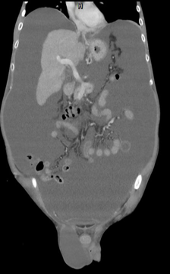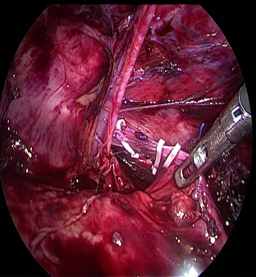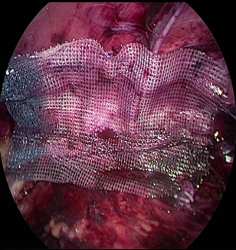大量腹水病人使用腹膜外腹腔鏡疝氣修補手術
陳怡璇、闕光瞬
高雄市立大同醫院
Laparoscopic totally extraperitoneal (TEP) inguinal hernia repair in patients with massive ascites
Chen Yi-Hsuan, Kuang-Shun Chueh
Department of Urology, Kaohsiung Municipal Ta-Tung Hospital, Kaohsiung, Taiwan
Case description:
A 51-year-old male with liver cirrhosis and massive ascites presented at the Urology outpatient department due to right inguinal bulging mass for several months. Abdominal CT showed massive ascites and right inguinal hernia(Figure 1).The laparoscopic totally extraperitoneal (TEP) inguinal herniorrhaphy was done with three ports. The indirect hernia sac was retracted and was free from spermatic cord(Figure 2). Hemolock was used and resected the sac, and no peritoneum perforation was noted(Figure 3). Mesh repair with Progrip was performed(Figure 4). Abdominocentesis with 2000 c.c fluid was done during operation. The patient was discharged two days after operation without postoperative complications. There was no recurrence nor chronic pain after 4 months follow up.
Figure.1 Figure.2


Figure.3 Figure.4


Discussion:
Compared with traditional open herniorrhaphy, laparoscopic totally extraperitoneal (TEP) inguinal hernia repair has the advantages of less blood loss, shorter recovery time, and less pain. However, TEP requires more techniques, especially performed on patients with massive ascites. Previous study enrolled 17 patients with liver cirrhosis, and three of them had large amounts of ascites. All of the patients received TEP successfully, with no patients converted to Transabdominal preperitoneal approach (TAPP) or open repair. Patients with liver cirrhosis usually accompanied with coagulopathy and laparoscopy have the benefit of less blood loss. So, TEP is a safe and feasible operation for selective patients with massive ascites.
References:
- Wang H, Fu J, Qi X, Sun J, Chen Y. Laparoscopic totally extraperitoneal (TEP) inguinal hernia repair in patients with liver cirrhosis accompanied by ascites. Medicine (Baltimore). 2019 Oct;98(43):e17078. doi: 10.1097/MD.0000000000017078. PMID: 31651835; PMCID: PMC6824811.
- Aditya Kumar, Manjunath Maruti Pol. Laparoscopic total extraperitoneal (TEP) mesh repair for femoral hernia in a patient of child B liver cirrhosis with ascites. A case report. International Journal of Surgery Case Reports(72), 2020, 298-300. https://doi.org/10.1016/j.ijscr.2020.05.091